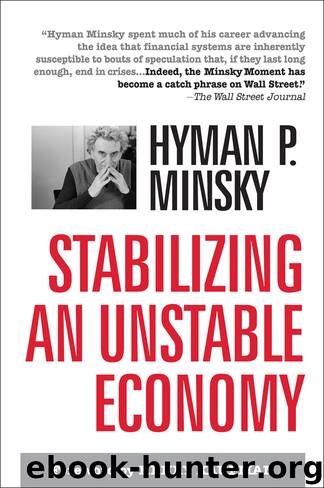Stabilizing an Unstable Economy by Hyman P. Minsky

Author:Hyman P. Minsky
Language: eng
Format: epub
Publisher: McGraw-Hill Education
Published: 2008-04-12T04:00:00+00:00
Figure 8.1: Price Level of Capital Assets: Relation to Money Supply and Alternative Expectations Environments
An exception to that rule occurs, however, whenever an increase in the amount of insurance against default on payment commitments does not lower the premium a holder is willing to pay for such insurance. Such an infinitely elastic demand for insurance arises only if the likelihood is believed to be high that cash shortfalls and default will occur. But such expectations happen only if recent and current experience is replete with shortfalls and defaults. After a debt deflation that induces a deep depression, an increase in the money supply with a fixed head count of other assets may not lead to a rise in the price of other assets. An insatiable demand for liquidity is a pathological condition, which may have been approximated in the United States at the end of the great 1929–33 collapse (Figure 8.1, PK Post debt-deflation, 1).
Therefore, there exists a functional relation between the price, PK, of a particular or a representative capital or financial asset and the quantity of money, M. Normally the price of a capital asset is a rising function of the quantity of money, for as the quantity increases the value of the insurance embodied in money decreases. As the price of money is always one, this implies that the price level of income-yielding capital assets increases. Furthermore, the functional relation has a logarithmic shape unless:
1. there exists the aforementioned infinitely elastic demand for the insurance provided by liquidity at a given fixed subjective valuation or,
2. the insurance embodied in money is deemed to be of no or decreasing value because prices are expected to rise more rapidly than the value of insurance.
In the special case of the infinitely elastic demand for liquidity as insurance, the price of capital assets may very well fall even when the money supply is increased. (There is a run to money (PK (Post debt-deflation, 2)).) In the case of inflation expectations, however, the price of tangible assets may increase at a more rapid rate than the increase in the money supply; there is a run from money (PK (Inflation) Figure 8.1).
But more important than the possible shapes of the relation is the fact that the function shifts as experience changes expectations of the cash flows that capital and financial assets will yield and the worth attached to holding money. (Indication by arrows in Figure 8.1.) It is not so much the movement along these curves as shifts from one of the relations that reflect normal, inflation, and depression valuations of liquidity to another that calls the tune to which the economy dances.
The effect of liquidity upon the relative prices of different capital assets and the index of capital asset prices are measured by PKi, M functions. We start with the statement that capital assets are valuable because of the quasirents, the QKi, they are expected to earn. Let us assume an initial unemployment situation and a Patinkin process begins. As the Patinkin
Download
This site does not store any files on its server. We only index and link to content provided by other sites. Please contact the content providers to delete copyright contents if any and email us, we'll remove relevant links or contents immediately.
International Integration of the Brazilian Economy by Elias C. Grivoyannis(74752)
The Radium Girls by Kate Moore(11621)
Turbulence by E. J. Noyes(7700)
Nudge - Improving Decisions about Health, Wealth, and Happiness by Thaler Sunstein(7242)
The Black Swan by Nassim Nicholas Taleb(6764)
Rich Dad Poor Dad by Robert T. Kiyosaki(6174)
Pioneering Portfolio Management by David F. Swensen(6078)
Man-made Catastrophes and Risk Information Concealment by Dmitry Chernov & Didier Sornette(5646)
Zero to One by Peter Thiel(5488)
Secrecy World by Jake Bernstein(4388)
Millionaire: The Philanderer, Gambler, and Duelist Who Invented Modern Finance by Janet Gleeson(4094)
The Age of Surveillance Capitalism by Shoshana Zuboff(3983)
Skin in the Game by Nassim Nicholas Taleb(3965)
The Money Culture by Michael Lewis(3846)
Bullshit Jobs by David Graeber(3830)
Skin in the Game: Hidden Asymmetries in Daily Life by Nassim Nicholas Taleb(3722)
The Dhandho Investor by Mohnish Pabrai(3560)
The Wisdom of Finance by Mihir Desai(3523)
Blockchain Basics by Daniel Drescher(3329)
